Famous Religious Paintings – Explore the Art of Biblical Paintings
Biblical paintings employ religious motifs and themes typically with an identifiable moral story or an intention to elicit powerful spiritual feelings in the audience. Religious art is described in the West as any work of art with a Christian subject, and many religious portraits and scenes are Catholic paintings as they were commissioned by the church. Scenes from Jesus Christ’s life and the Old Testament dominate Christian paintings. In this article, we will explore the most famous religious paintings ever produced in Christian artwork.
Famous Religious Paintings
Most of the most renowned Christian paintings were made during the Renaissance, an artistic movement that began in Italy. Among the most often portrayed subjects in religious art are Christ on the cross and Mary cradling the newborn Christ. Here is our list of the top famous religious paintings.
The Last Supper (1498) by Leonardo da Vinci
| Artist | Leonardo da Vinci (1452 – 1519) |
| Date Completed | 1498 |
| Medium | Tempera, mastic, pitch, gesso |
| Location | Santa Maria delle Grazie, Milan, Italy |
This Christian artwork is considered a Renaissance masterpiece, even though it has battled to stay intact throughout the ages. It was ordered by Duke Ludovico Sforza for the dining hall of the convent of Santa Maria delle Grazie in Milan, and Leonardo painted it on drywall with an oil and tempera combination. He did this to replicate the look of an oil-on-canvas, but it started to fade even within his lifetime.
In the 17th century, a door was carved into the bottom, causing further damage (clearly, Da Vinci’s paintings were not valued at the time as they are now).

Figures are seen in a rectangular chamber with vaults on the ceiling and tapestries on either side. In terms of composition, Jesus is in the middle of the apostles, and his body makes a triangle-like shape that is not overlapping by any of the apostles. In addition to being the focal point of the composition, Christ is also the focal point of psychology. Although the Last Supper has been represented in art many times before, this specific scene in the tale has not.
This dramatic event allows Leonardo da Vinci to investigate the psychological emotions of the characters concerned.
The Creation of Adam (1512) by Michelangelo
| Artist | Michelangelo di Lodovico Buonarroti Simoni (1483 – 1520) |
| Date Completed | 1512 |
| Medium | Fresco painting |
| Location | Sistine Chapel, Vatican City |
Creation of Adam by Michelangelo is merely a little area of the Sistine Chapel ceiling, yet something about it stands out. It is one of the most famous Catholic paintings in European art history. It depicts more than just the artist’s daring point of view – it’s no surprise that the picture, even when placed alongside the Creation of Eve, is the most famous piece of the Sistine Chapel ceiling. Most artists in Michelangelo’s time made their art in a single style.
Creation scenes were a typical theme, but the Creation of Adam pushed the bounds of painting and deviated from the norm.
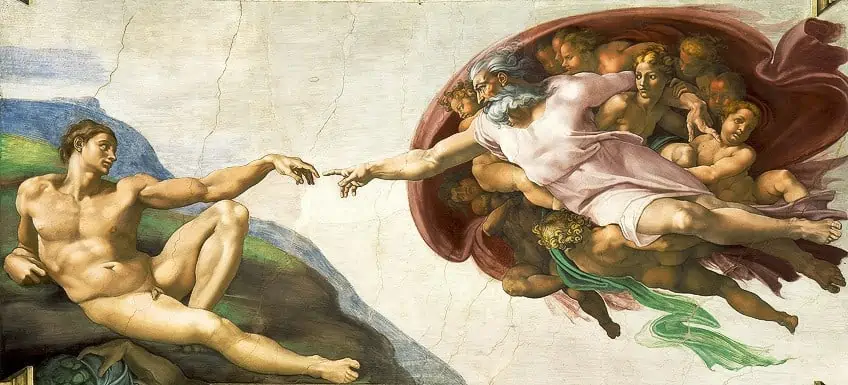
A depiction of God and a figure of Adam dominate the image. Adam, who is placed on the left-hand side, is depicted loosely. His figure looks to be reacting to God’s impending touch, which is where the title originates. Adam is getting life directly from the source, and by the life he receives, he will give life to all of mankind. Religious subjects supplied some of the most inspiring content for Renaissance painters.
In some ways, this image symbolizes more than the genesis of the first man; it depicts the very beginning of what would eventually become the human species.
Adam’s form is curved as he extends out to God, implying that man is fashioned in the image of God himself. The way the two dominating figures link and correlate to each other suggests Adam’s strong relationship with his maker. Michelangelo designed it such that the figure of Adam mimics the form of God, almost as though one is nothing more than an extension of the other.
Sistine Madonna (1512) by Raphael
| Artist | Raffaello Sanzio da Urbino (1483 – 1520) |
| Date Completed | 1512 |
| Medium | Oil on canvas painting |
| Location | Old Masters Gallery, Dresden, Germany |
Raphael’s masterpiece of religious art – a masterwork of High Renaissance painting – was the final of his Madonnas and one of the last pieces he painted himself. It was authorized by Pope Julius II and put on the high altar of the Benedictine monastery church of San Sisto, making it one of the finest instances of altarpiece art. Scholars regard it as one of the best Christian paintings of the Italian Renaissance.
This magnificent work of Renaissance art incorporates a harmonic balanced design, illusionism, and ecclesiastical language.
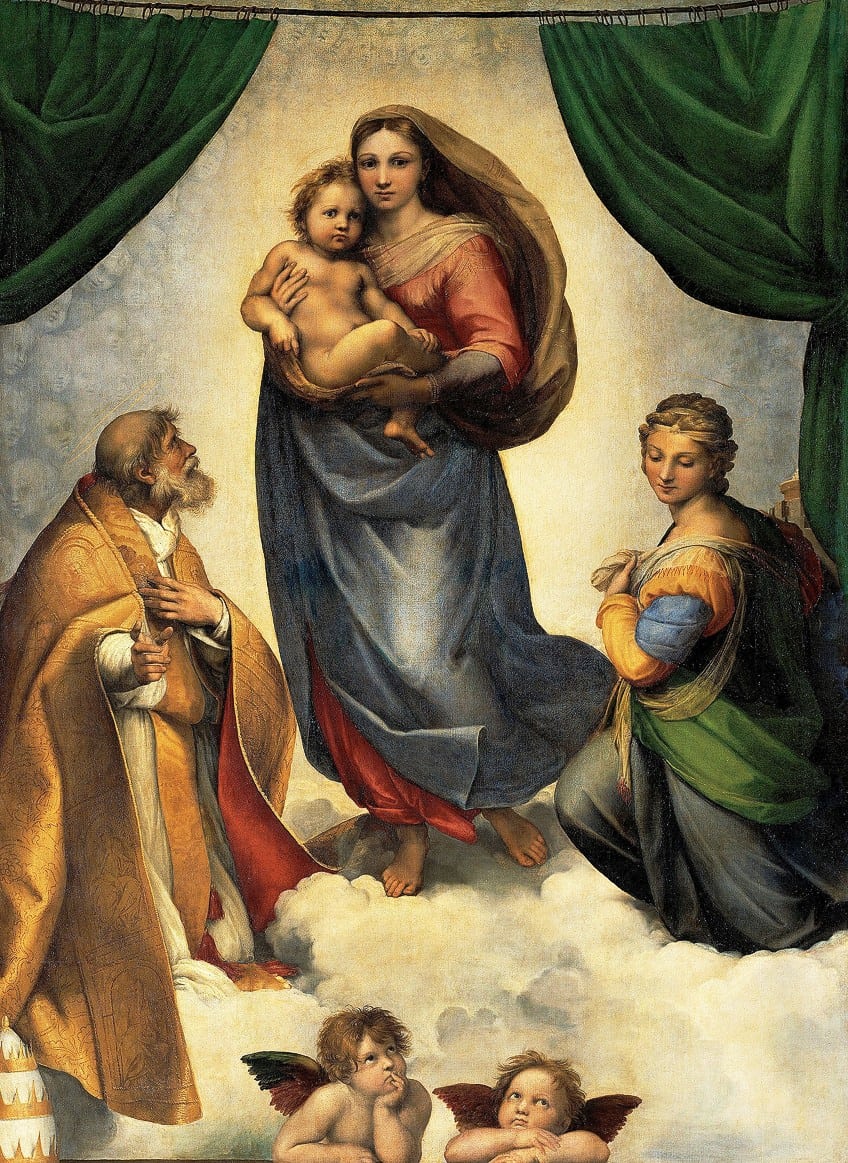
The Madonna is cradling the Christ Child at the top. Saint Sixtus looks up to Mary lower down to the left of the painting, his right hand gesturing forth to the devoted throng. Saint Barbara, who stands opposite and inspects the situation with her downward glance, joins him in this act of mediating between the celestial Madonna and the earthy plane of the observer.
Two beautiful winged cherubs are shown at the bottom of the painting, resting on their elbows and looking listlessly at the three characters above them.
Transfiguration (1520) by Raphael
| Artist | Raffaello Sanzio da Urbino (1483 – 1520) |
| Date Completed | 1520 |
| Medium | Oil tempera on wood |
| Location | Pinacoteca Vaticana, Vatican City |
Raphael made Transfiguration, a huge tempera on wood artwork, from 1516 until 1520. The picture would be the Italian Renaissance master’s final work before his passing. It illustrates two unique biblical stories from Mark and Matthew’s Gospels. The first is the Transfiguration of Christ, in which Elijah and Moses stand on either side of Christ, as John and James watch. The second section of the picture tells the tale of the Apostles failing to heal a sick child while waiting for Jesus’ return.
The painting’s top half depicts the Transfiguration on Mount Tabor.
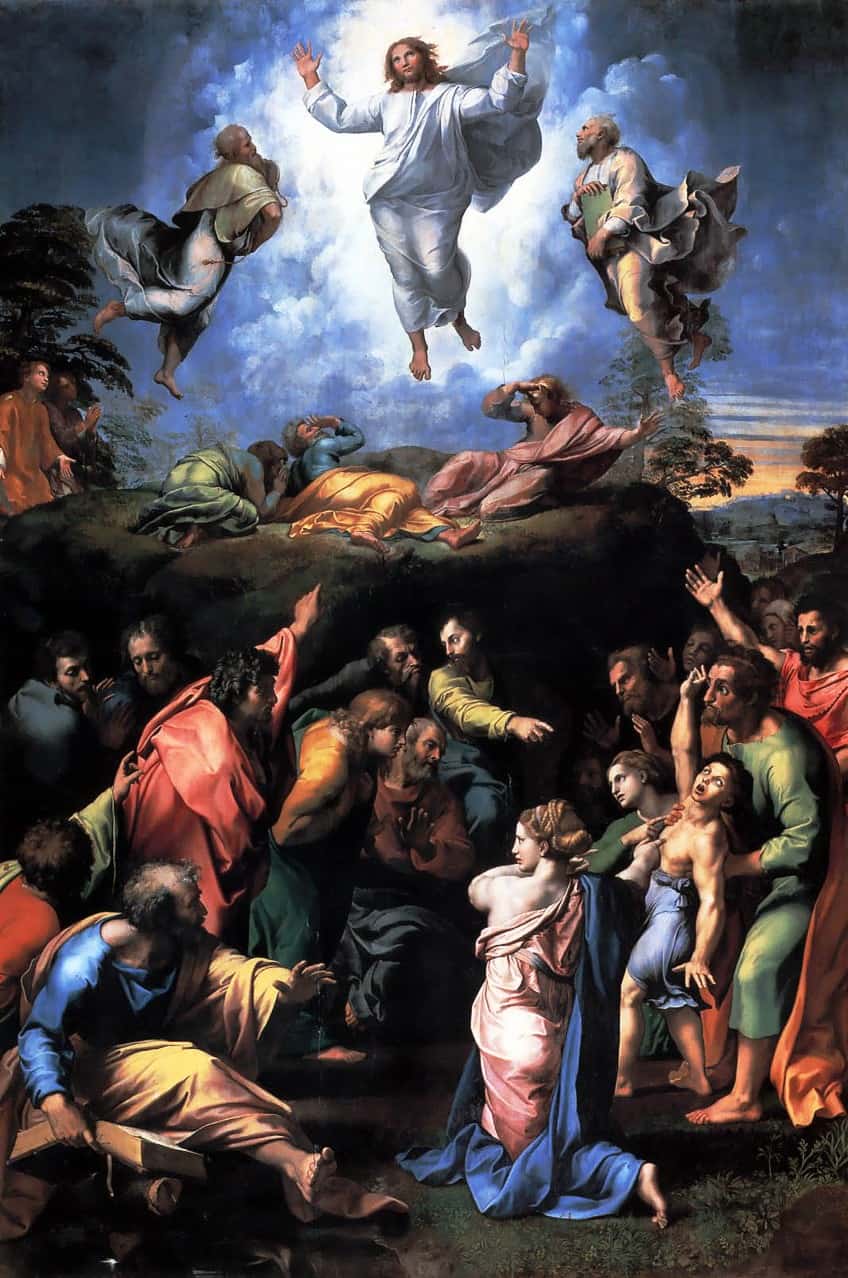
Between the two prophets, Jesus is seen hovering in front of clouds. Pastor and Justus, two saints who share the Transfiguration feast day, are located to the left of John and James. The stylized and deformed positions of the characters in the lower half of the Transfiguration are reminiscent of Mannerism, while the dynamic friction between the figures and the application of chiaroscuro is reminiscent of Baroque painting.
Raphael died before finishing the artwork, however, he did complete the majority of the picture. While the artist lay in state, the artwork was put near his head.
The Last Judgment (1541) by Michelangelo
| Artist | Michelangelo di Lodovico Buonarroti Simoni (1483 – 1520) |
| Date Completed | 1541 |
| Medium | Fresco painting |
| Location | Sistine Chapel, Vatican City |
Michelangelo had an unequaled impact on the evolution of western art. He is largely recognized as the finest sculptor of all time, and despite his disdain for painting, he is also recognized as one of the best painters. This painting is among the most prominent frescoes in Western art history. It portrays Christ’s second coming and God’s final and permanent judgment of all mankind on the altar wall of the Sistine Chapel in Vatican City.
The picture depicts Jesus in the middle, surrounded by renowned saints, with the dead being resurrected as well as the damneds’ descent into Hell depicted in the zone below.
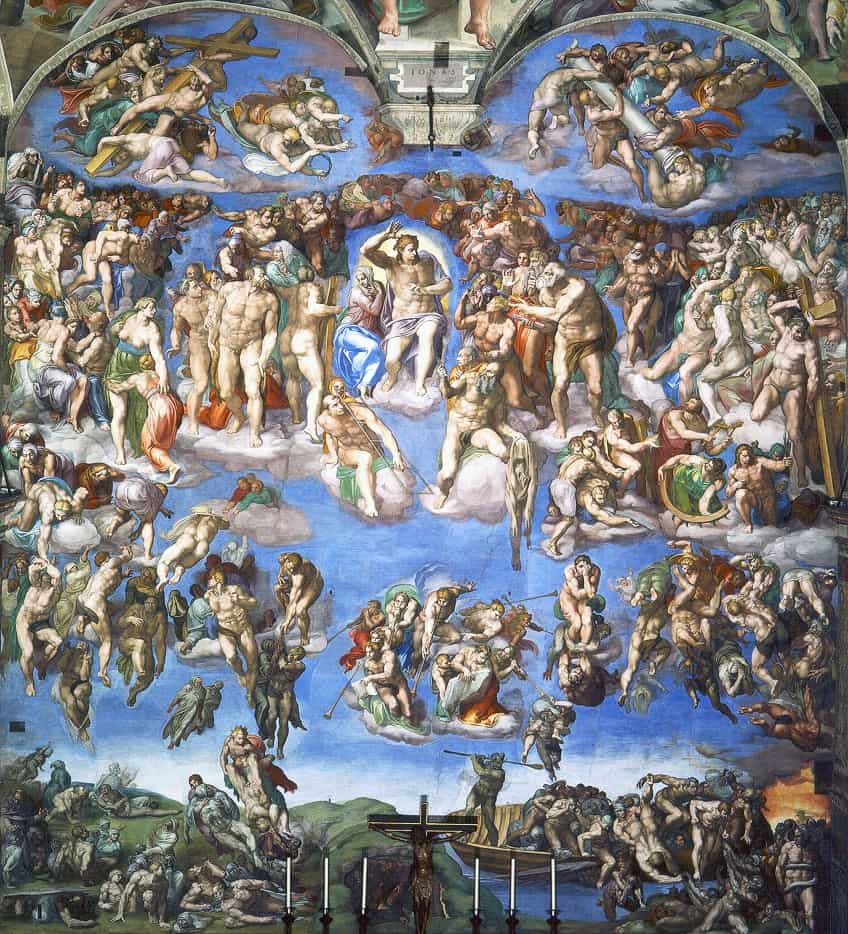
Despite being one of the most famous religious paintings, it sparked great debate. Michelangelo was criticized, among other things, for incorporating characters from pagan mythology into depictions of Christian subjects and for prioritizing aesthetic effect above scriptural accuracy. The three major characters are framed by huge drapes that have been opened to display the beautiful sight.
They are standing in the traditional triangle formation atop a blanket of clouds, looking down on the church crowd that would be assembling below.
The Burial of the Count of Orgaz (1588) by El Greco
| Artist | Doménikos “El Greco” Theotokópoulos (1541 – 1614) |
| Date Completed | 1588 |
| Medium | Oil paint on canvas |
| Location | Church of Santo Tomé, Toledo, Spain |
The priest of Santo Tomé in Toledo, commissioned El Greco to create this picture in 1586. It depicts a traditional local tale in which Saints Stephen and Augustine descended from the heavens to aid in the burial of Don Gonzalo Ruz, a Toledo local noted for his benevolence and devotion who was posthumously honored as Count of Orgaz.
The lower portion of the picture represents the miracle burial, while the upper section displays the spiritual realm awaiting the devout man’s entrance into paradise.
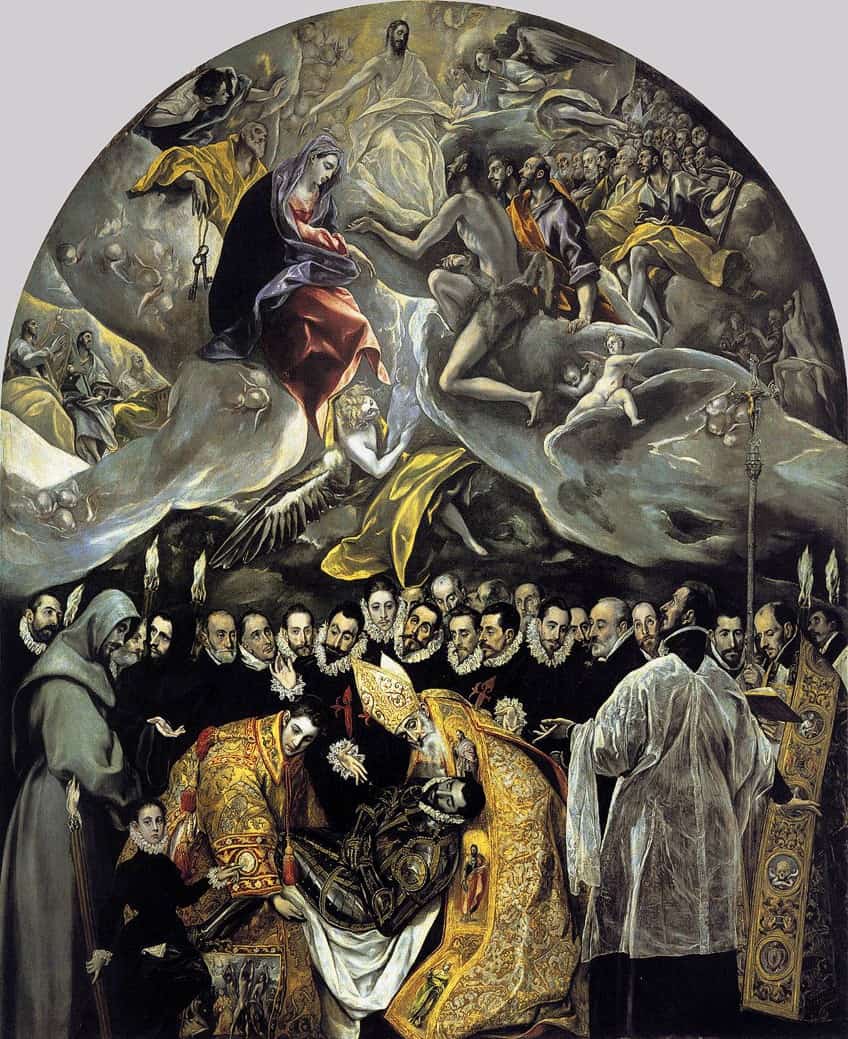
Because the piece is a classic example of Mannerism, shows a visionary experience, and has an outstanding array of portraits, art experts consider it the culmination of all of El Greco’s extraordinary characteristics. It is widely recognized as his best work and maybe the most renowned religious portrait of the Spanish Renaissance.
El Greco is said to have added himself to the artwork as the person next to Saint Stephen, staring directly out at the viewer.
The Calling of St Matthew (1600) by Caravaggio
| Artist | Michelangelo Merisi da Caravaggio (1571 – 1610) |
| Date Completed | 1600 |
| Medium | Oil on canvas painting |
| Location | San Luigi dei Francesi, Rome, Italy |
Historically, the topic was depicted either outside or indoors; Saint Matthew is sometimes shown within a structure, with Christ outside beckoning him through a window. The theme was frequently utilized as a premise for narrative genre paintings both before and after Caravaggio. Caravaggio may have seen previous Netherlandish paintings depicting gamblers sitting around a table, such as Saint Matthew and his companions.
Caravaggio depicted the scene as though it were a virtually quiet, dramatic story. The sequence of events preceding and following this point may be readily and effectively recreated.
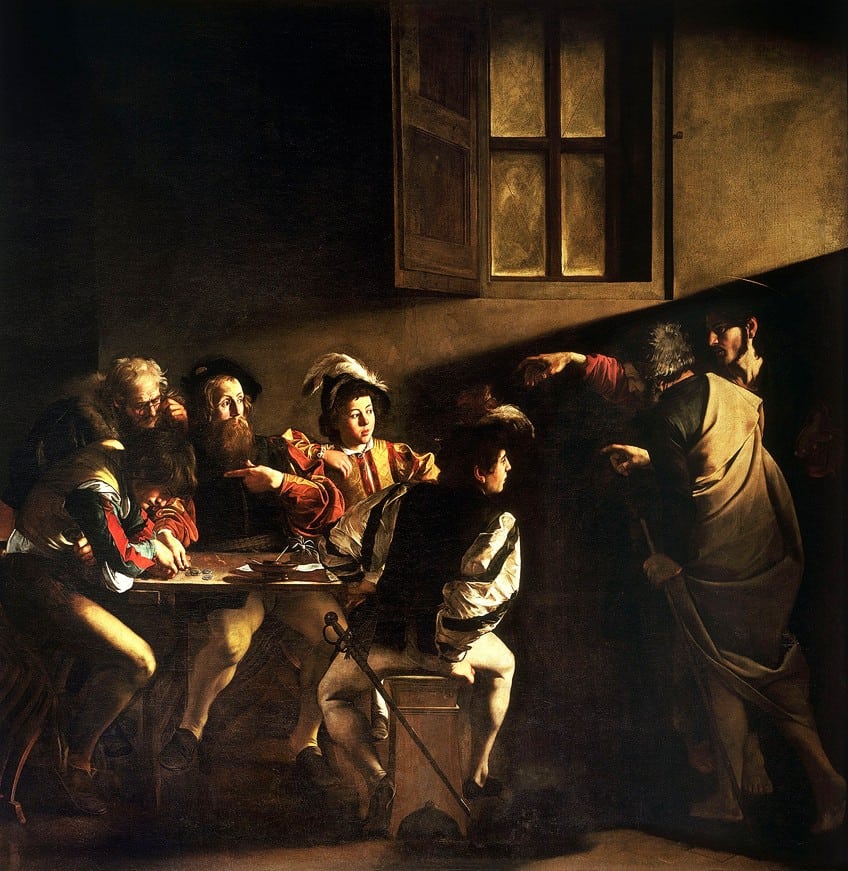
Levi, the tax collector, was sitting at a tabletop with his four subordinates, counting the day’s revenues, the group lit by a source in the artwork’s top right corner. Christ arrives with Saint Peter, His eyes hidden and His halo the sole evidence of divinity. Levi is summoned by a motion of His right hand, made all the more forceful and captivating by its languor. Startled by the interruption and maybe disoriented by the unexpected light from the newly opened door, Levi steps back and points toward himself, as if to exclaim, “Who, me?”
His right-hand remains on the money he had been recounting before Christ’s entry.
The Return of the Prodigal Son (1669) by Rembrandt
| Artist | Rembrandt van Rijn (1606 – 1669) |
| Date Completed | 1669 |
| Medium | Oil on canvas painting |
| Location | Hermitage Museum, Saint Petersburg, Russia |
All energy has disappeared in Rembrandt’s religious artwork Son, one of his final works before his death. The father places his hands on the shoulders of the shaved penitent clad in ragged clothing. His soft motions demand stillness even with his eyes half-closed. The act of forgiving takes on almost holy significance. This is a depiction of complete spiritualization, devoid of any anecdotal elements, in which all movement and motion have come to a halt.
According to St. Luke, the elder brother on the right rebuked his father.
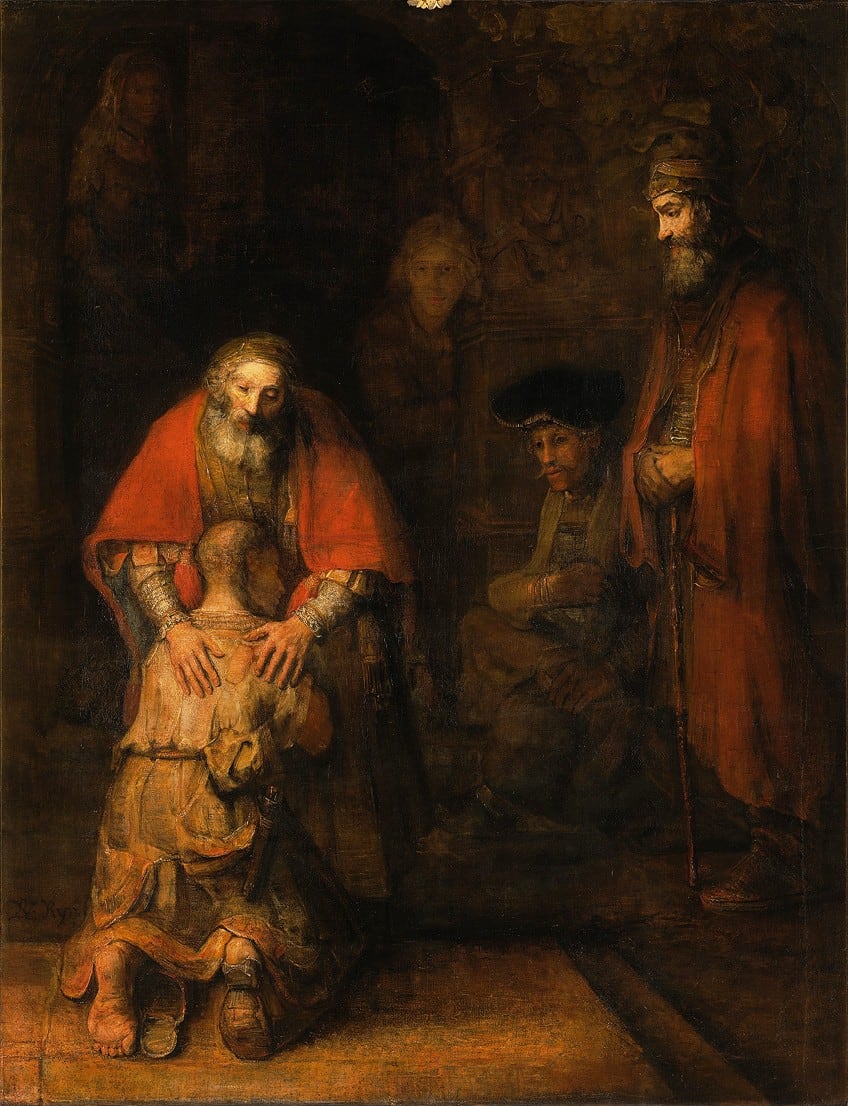
“See, I have obeyed you for numerous years and never violated your rules, but now he, who squandered your wealth with harlots, has arrived, and you have slaughtered the fattened calf for him.” Rembrandt, on the other hand, eliminates the words, enabling him to participate in this powerful moment in solitude. The scenario is immersed in cellar-like darkness, from which the father and his oldest son’s pallid features emerge, their crimson capes illuminating the gloom.
Rembrandt, despite his talent, avoided artistic complexity in favor of a pittura povera, which emphasized simplicity.
The Angelus (1859) by Jean-François Millet
| Artist | Jean-François Millet (1814 – 1875) |
| Date Completed | 1859 |
| Medium | Oil on canvas painting |
| Location | Musée d’Orsay, Paris, France |
This remarkable example of Christian artwork portrays a deep sense of religious dedication and would become one of the most extensively printed biblical paintings of the 19th century, with reproductions exhibited by thousands of devoted homeowners across France. Millet, on the other hand, painted it out of sentimentality rather than a deep religious conviction.
In 1865, he acknowledged that the inspiration for The Angelus stemmed from a boyhood recollection of his grandmother, who always urged that the family stop working in the fields when the church bell rang for the Angelus.

The picture portrays two peasant people – a woman and a man – who have ceased laboring for a few minutes to say the Angelus, a prayer commemorating the Annunciation. The image is set in the potato harvesting season, just outside the Barbizon town of Chailly-en-Biere, whose church spire can be seen in the background.
The couple was harvesting potatoes when they noticed the church bells, and their equipment, including a pitchfork, bags, and wheelbarrow, were scattered around them.
Christ of Saint John of the Cross (1951) by Salvador Dalí
| Artist | Salvador Dalí (1904 – 1989) |
| Date Completed | 1951 |
| Medium | Oil paint on canvas |
| Location | Kelvingrove Art Gallery and Museum, Glasgow, Scotland |
This is undoubtedly the most well-known of Dalí’s religious works, whose figure overlooks the Bay of Port Lligat. The picture was influenced by a sketch housed at the Convent of the Incarnation in Avila, Spain, and completed by Saint John personally after seeing this vision of Christ in ecstasy.
The individuals near the boat are based on Le Nain’s painting and Diego Velazquez’s sketch for The Surrender of Breda (1635).
Dalí writes at the bottom of his Christ studies: “First and foremost, in 1950, I had a ‘cosmic dream’ in which I saw this picture in color and which symbolized the ‘nucleus of the atom’ in my vision. This nucleus eventually took on a philosophical significance; I thought the Christ to be ‘the very oneness of the cosmos!’ Later, when I saw the Christ painted by Saint John owing to the teachings of Father Bruno, a Carmelite, I figured out mathematically a triangle and a circle that artistically encapsulated all my earlier attempts, and I put my Jesus in this triangle.”
And with that, we conclude our look at the top ten famous religious paintings of all time. These Protestant and Catholic paintings were created to remind people of the power of God, and keep them devoted to the church and religion. Biblical paintings were popular because they allowed the artist to depict a certain moral or psychological message.
Frequently Asked Questions
Why Were Christian Paintings Produced?
If a church were a business, then religious portraits and Christian artwork serve as its advertising. This was especially useful in the centuries when the populace was still largely illiterate and could not read or understand the scripture for themselves. These religious artworks would depict a moral story that could be observed by the common man and comprehended through its context.
What Are the Most Common Themes in Christian Paintings?
The most common themes concern the birth and death of Jesus Christ. The early years of his life are usually linked to his devotion to his mother, the Virgin Mary. Other common themes that appear in biblical paintings are images of the betrayal of Christ, his miracles, and the saints and disciples who followed him. Many Christian religious artworks also focus on the mother of Christ, as she plays a large part in the religion.
Jordan Anthony is a Cape Town-based film photographer, curator, and arts writer. She holds a Bachelor of Art in Fine Arts from the University of the Witwatersrand, Johannesburg, where she explored themes like healing, identity, dreams, and intuitive creation in her Contemporary art practice. Jordan has collaborated with various local art institutions, including the KZNSA Gallery in Durban, the Turbine Art Fair, and the Wits Art Museum. Her photography focuses on abstract color manipulations, portraiture, candid shots, and urban landscapes. She’s intrigued by philosophy, memory, and esotericism, drawing inspiration from Surrealism, Fluxus, and ancient civilizations, as well as childhood influences and found objects. Jordan is working for artfilemagazine since 2022 and writes blog posts about art history and photography.
Learn more about Jordan Anthony and about us.
Cite this Article
Jordan, Anthony, “Famous Religious Paintings – Explore the Art of Biblical Paintings.” artfilemagazine – Your Online Art Source. October 25, 2022. URL: https://artfilemagazine.com/famous-religious-paintings/
Anthony, J. (2022, 25 October). Famous Religious Paintings – Explore the Art of Biblical Paintings. artfilemagazine – Your Online Art Source. https://artfilemagazine.com/famous-religious-paintings/
Anthony, Jordan. “Famous Religious Paintings – Explore the Art of Biblical Paintings.” artfilemagazine – Your Online Art Source, October 25, 2022. https://artfilemagazine.com/famous-religious-paintings/.



